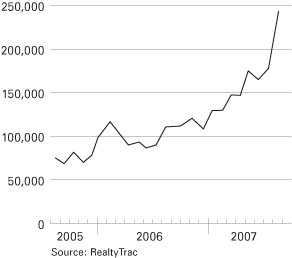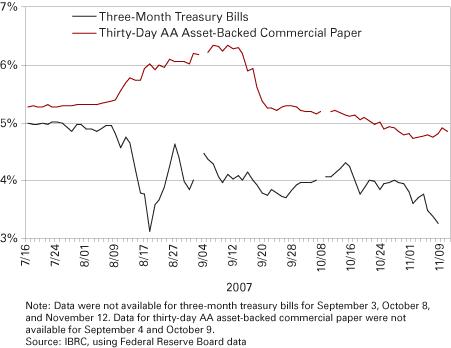Housing
Director, Benecki Center for Real Estate Studies; Charles H. and Barbara F. Dunn Professor of Finance and Real Estate, Kelley School of Business, Indiana University Bloomington
The housing slump that started in 2006 continued to worsen in 2007 as the term “subprime mortgage” entered many people's vocabulary for the first time. A subprime loan is a loan made to someone who does not qualify for a more favorable rate because of low credit scores. These loans have higher interest rates and fees than prime loans and are often issued by mortgage brokers who are not regulated. During the boom in home prices in 2004 and 2005, lenders became increasingly aggressive in making subprime loans and often required little if any documentation of the borrower's income. Of all the mortgage loans made in 2005, 29 percent were subprime loans, up 88 percent from 2004. The loans were often given, at close to 100 percent of the home's value, to borrowers who were stretched to make the monthly payments. As long as home prices were rising, borrowers could refinance the home and take out cash to help cover their mortgage payments. An increasing proportion of the subprime loans issued in recent years were adjustable rate mortgages (ARMs). These loans had an initial “teaser” rate (also called “exploding ARMs”)—meaning the rate was artificially low during the initial term of the mortgage but would reset to a higher interest rate even if mortgage interest rates stayed the same.
During 2007, when the rate on these ARMs was due to reset, interest rates had risen. So the interest rate on the loans increased due to both rising mortgage rates and because the initial interest rate was a teaser rate. This resulted in borrowers facing payment shock when their mortgage payments were increased substantially and they could no longer afford the payments. Furthermore, because home prices were no longer appreciating, borrowers could not refinance to help cover their costs. What took credit markets by surprise was the number of borrowers who were caught in this situation and defaulted on their loans. Clouding the outlook is the fact that approximately 2.5 million loans are still set to adjust upward in 2008; thus, the number of foreclosures in 2008 is likely to be very high.
According to RealtyTrac, a company that tracks foreclosures, the number of foreclosures in 2007 will double those in 2006. This pace of foreclosures could continue into 2008 unless lower interest rates help to mitigate the problem (see Figure 1). The foreclosure rate is expected to be 21 percent for loans originated during 2006—when lending standards tended to be the most lax.
Figure 1
Total Foreclosures per Month Nationwide

As loans are foreclosed and the properties are put on the market, the supply of homes for sale increases, putting even more downward pressure on home prices. This results in even more borrowers having negative equity in their home and no incentive to keep making mortgage payments. The results can be especially devastating in neighborhoods with a high percentage of lower income borrowers who could only qualify for subprime mortgages.
Because many of the subprime mortgages were packaged into securities that were purchased through hedge funds and other vehicles by investors around the world, the impact of the losses due to foreclosures on the subprime mortgages has turned out to be much more extensive than anyone imagined. Over $1.8 trillion of securities backed by subprime mortgages were created since the year 2000. The news media have been filled with stories of huge losses by hedge funds that had invested in securities backed by subprime mortgages. Furthermore, as the risks of these securities became more apparent, lenders tightened up their lending requirements. These requirements made it even more difficult to obtain financing—not only for subprime loans but for prime mortgage loans and loans on commercial real estate. The concern about the risk of subprime mortgages spilled over to impact the entire credit market.
Spreads remain abnormally wide between risk-free Treasury bills and asset-backed commercial paper, considered riskier because the assets backing this short-term debt issued by financial institutions may include subprime residential mortgages (see Figure 2). Commercial property sales are closing, but many deals are being delayed, renegotiated, or cancelled. Prices have dropped for most property types, with riskier assets in secondary markets bearing the brunt of the increase.
Figure 2
Three-Month Treasury Bills and Thirty-Day AA Asset-Backed Commercial Paper

Undoubtedly, the mortgage market meltdown has had a major impact on the housing market over the past year. However, the question remains as to how strongly the meltdown's effects will be felt as we head into 2008 and beyond. According to Fed Chairman Ben Bernanke, the housing downturn has not yet hit bottom, and many economists predict we will not begin to see recovery until the fourth quarter of 2008 or later, depending on the restoration of the credit markets.
As a result of stricter mortgage standards, housing starts will continue to decrease. Total housing starts in the third quarter of 2007 were 22.6 percent lower than in the same quarter a year ago. Starts are projected to be in the range of about 1.2 million units during 2008, down from 1.4 million units during 2007 and 1.8 million units in 2006. Single-family starts during 2008 are expected to show a 50 percent decline from their peak in the first quarter of 2006.
In the third quarter of 2007, existing home prices were down 1.3 percent from a year earlier and new home prices were down 0.9 percent. This is the first year ever that home prices declined on a national basis. The median home price for an existing home dropped to $221,000 in the third quarter of 2007 from $225,000 in the third quarter of 2006. In areas hit by high foreclosure rates in the coming months, the increased supply of repossessed homes will lead to even lower prices. The National Association of Realtors estimates that existing home prices in the fourth quarter of 2007 will be down 2.5 percent from a year ago and new home sales will be down 3.3 percent. In the first quarter of 2008, existing home prices are predicted to be 0.6 percent below year-ago levels with new home prices down 1.5 percent.
The demand for rental units has been increasing as more people are unable to qualify for financing due to stricter credit standards, or are being forced out of their homes due to foreclosure. This trend will continue as the subprime mortgage crisis plays out—at least into the third quarter of 2008. Many condominiums are now being converted back into rental units at rates not seen since the 1980s, and builders are building more new rental units than condo developments.
The Fed's recent rate cut brought some relief by decreasing the rate for a thirty-year fixed mortgage from 6.5 percent in the third quarter to around 6.4 percent in the fourth quarter of 2007. However, rates are forecast to increase slightly by the third quarter of 2008 to 6.6 percent and then flatten out. Adjustable rate mortgages are in the 5.7 percent range for a one-year adjustable rate—the same as one year ago—and this rate is likely to continue.
The recovery of the housing market over the next year is going to depend partly on how the credit markets adjust. Many lenders are now more willing to renegotiate loans for those facing foreclosure. In some areas, homes can't be sold for more than the balance due on the mortgage because of the large supply of homes and the inflated prices at the time of purchase. Further foreclosures will be the main culprit in prolonging the housing market crisis and anything that can be done to lessen the number of foreclosures is likely to speed up recovery. However, the credit market can only do so much. As Ben Bernanke has warned, loosening standards or lowering rates on new loans is not the way to spur recovery and could lead to riskier investments and future crises.
Despite the current subprime mortgage problem and the impact it has had on housing markets, many economists are hopeful that the market will recover late in 2008—as long as job growth continues in the economy and inflation stays under control so that interest rates can stay at current levels. The inventory of new homes for sale has been dropping as builders have cut back on the pace of housing starts and aggressively stepped up sales incentives. This should ultimately help provide some stability to the housing market.
Also in this Issue…
- Outlook for 2008
- The International Economy
- The U.S. Economy
- Financial Forecast
- Housing
- Indiana Agriculture
- Indiana
- Anderson
- Bloomington
- Columbus
- Evansville
- Fort Wayne
- Gary
- Indianapolis-Carmel
- Kokomo
- Louisville
- Muncie
- Richmond
- South Bend-Mishawaka and Elkhart-Goshen
- Terre Haute
- Return to Table of Contents



